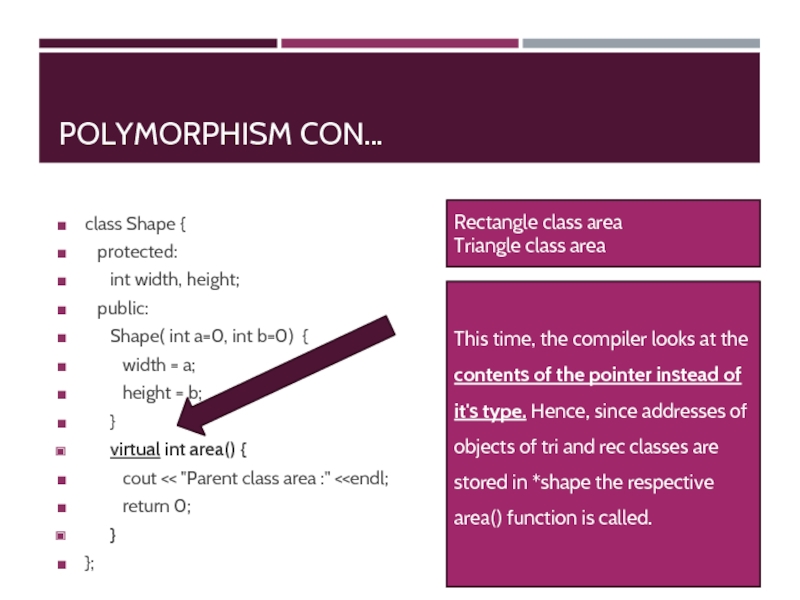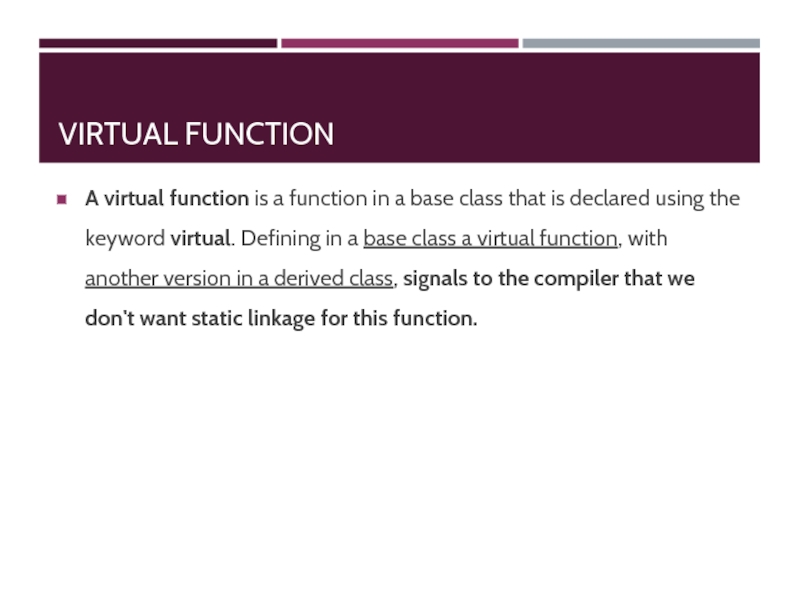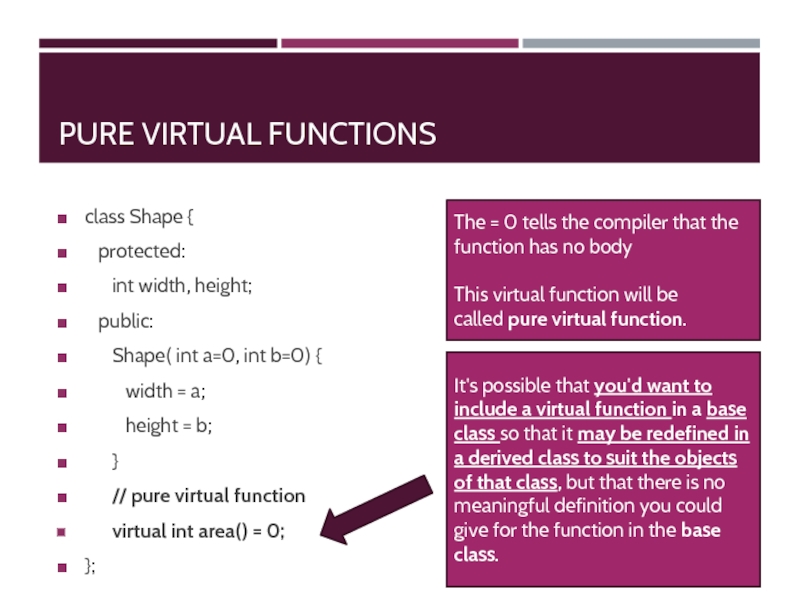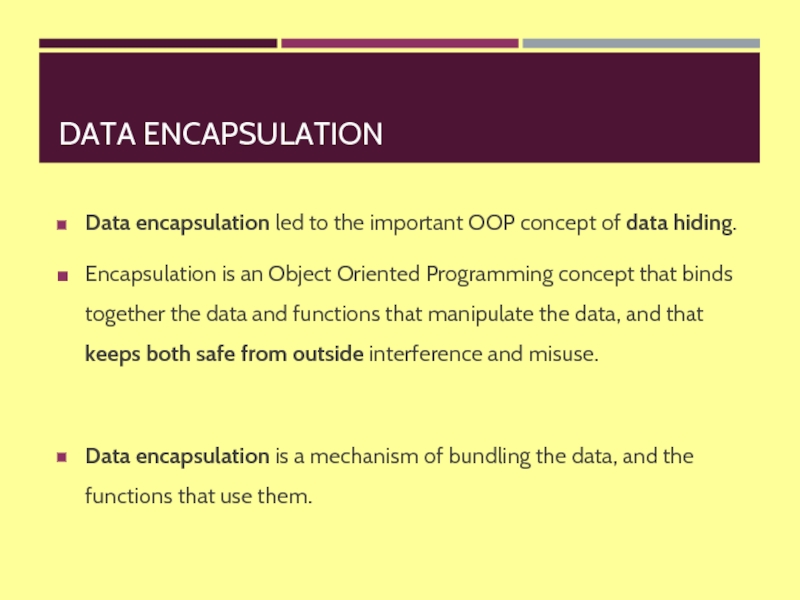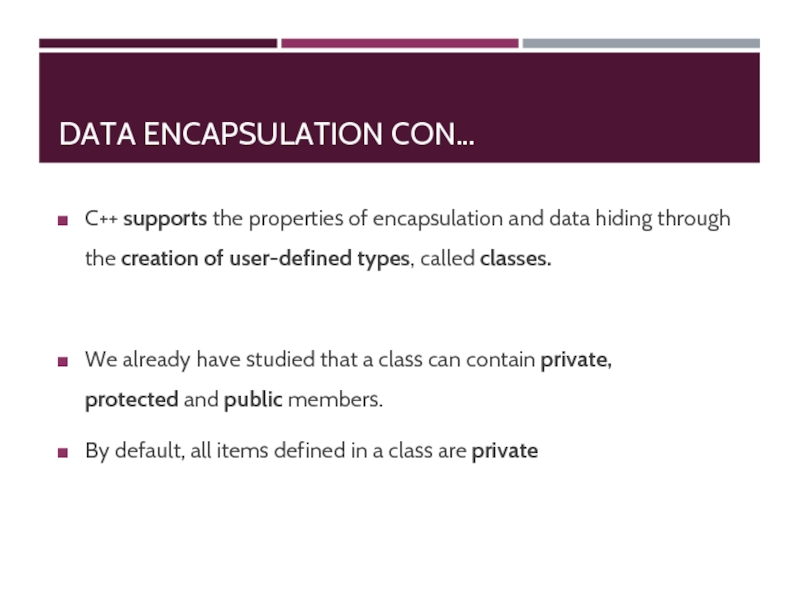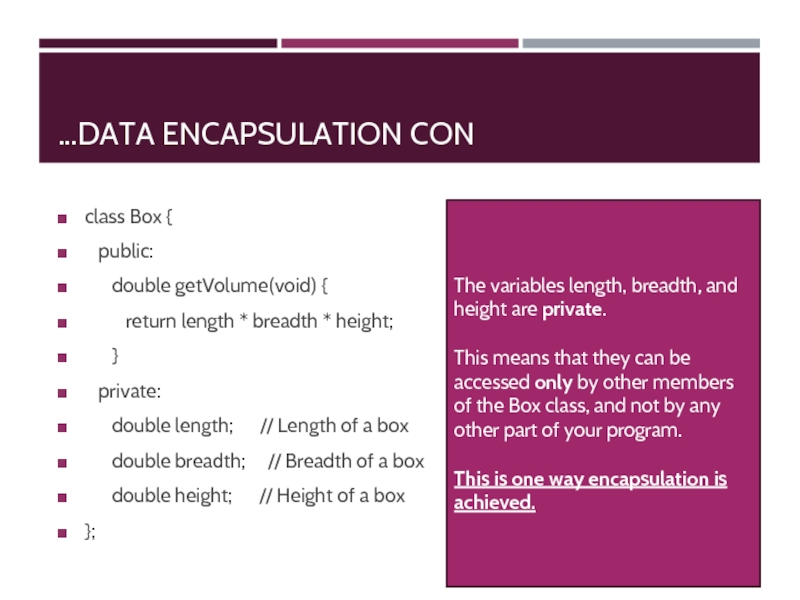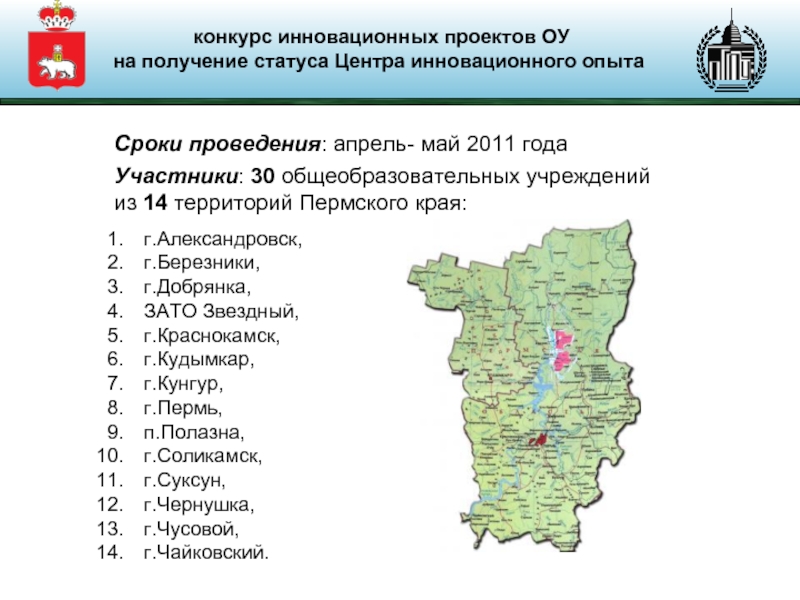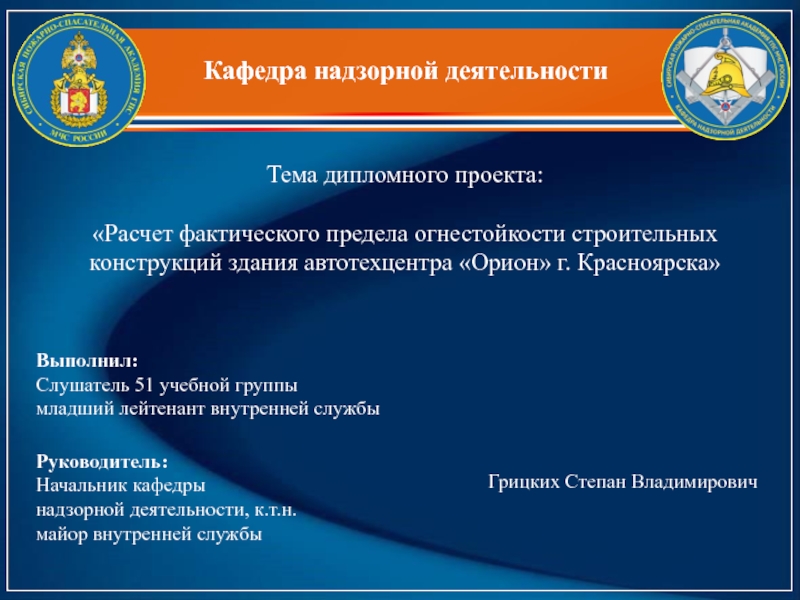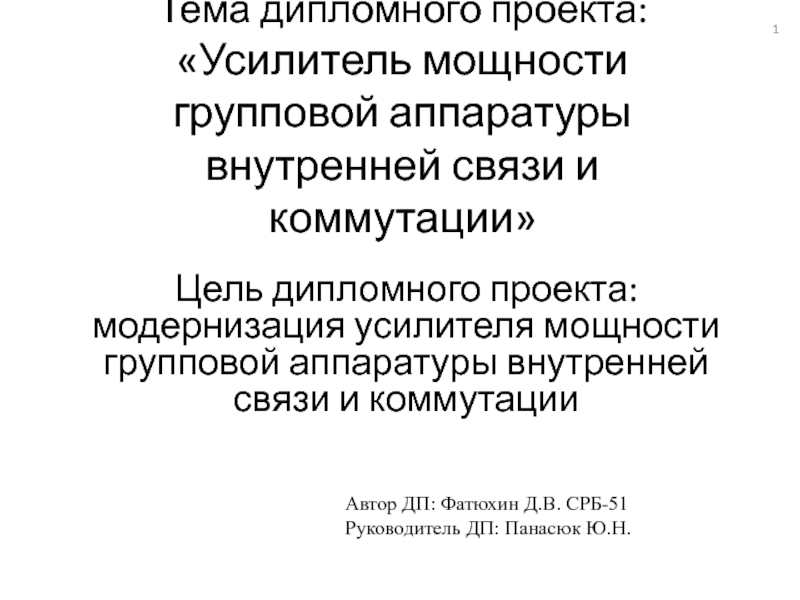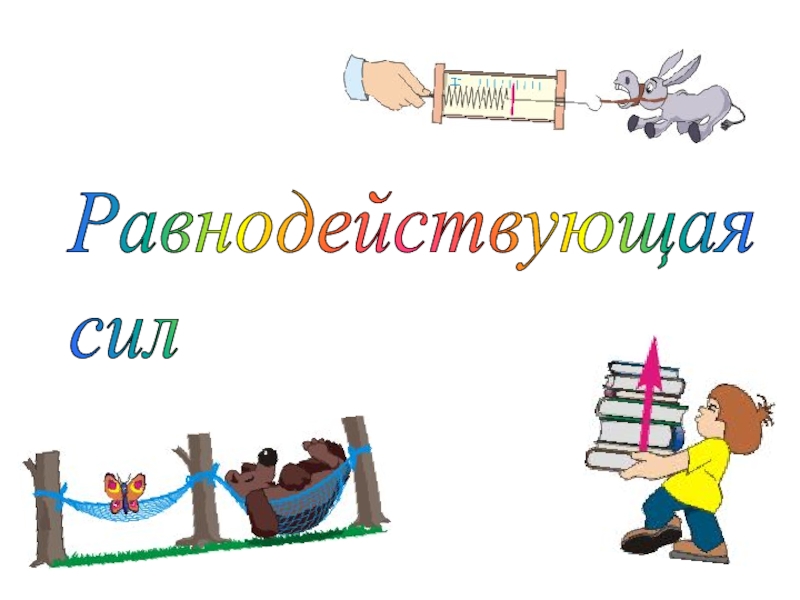- Главная
- Разное
- Дизайн
- Бизнес и предпринимательство
- Аналитика
- Образование
- Развлечения
- Красота и здоровье
- Финансы
- Государство
- Путешествия
- Спорт
- Недвижимость
- Армия
- Графика
- Культурология
- Еда и кулинария
- Лингвистика
- Английский язык
- Астрономия
- Алгебра
- Биология
- География
- Детские презентации
- Информатика
- История
- Литература
- Маркетинг
- Математика
- Медицина
- Менеджмент
- Музыка
- МХК
- Немецкий язык
- ОБЖ
- Обществознание
- Окружающий мир
- Педагогика
- Русский язык
- Технология
- Физика
- Философия
- Химия
- Шаблоны, картинки для презентаций
- Экология
- Экономика
- Юриспруденция
lec12 презентация
Содержание
- 1. lec12
- 2. CLASSES AND OBJECTS The main purpose of
- 3. CLASS ACCESS MODIFIERS Data hiding is one
- 4. CLASS ACCESS MODIFIERS class Base {
- 5. THE PUBLIC MEMBERS EXAMPLE A public member is accessible
- 6. THE PUBLIC MEMBERS EXAMPLE CON… // Member
- 7. THE PUBLIC MEMBERS EXAMPLE CON… // Main
- 8. THE PRIVATE MEMBERS A private member variable or function
- 9. THE PRIVATE MEMBERS EXAMPLE #include using
- 10. THE PRIVATE MEMBERS EXAMPLE CON… void Box::setWidth(
- 11. THE PROTECTED MEMBERS EXAMPLE A protected member variable or
- 12. THE PROTECTED MEMBERS EXAMPLE CON… class SmallBox:Box
- 13. THE PROTECTED MEMBERS EXAMPLE CON… void SmallBox::setSmallWidth(
- 14. CLASS DEFINITIONS When you define a class,
- 15. CLASS DEFINITIONS EXAMPLE class Box {
- 16. DEFINE C++ OBJECTS: Box Box1;
- 17. ACCESSING THE DATA MEMBERS #include using
- 18. ACCESSING THE DATA MEMBERS CON… int
- 19. ACCESSING THE DATA MEMBERS CON… //
- 20. CLASS MEMBER FUNCTIONS A member function of
- 21. CLASS MEMBER FUNCTIONS CON… Method 1 class
- 22. FULL EXAMPLE https://ideone.com/n9IX03
- 23. INHERITANCE “C++ is Multi Inheritance, unlike Java
- 24. BASE & DERIVED CLASSES A class can
- 25. FULL EXAMPLE Consider a base class Shape and its derived class Rectangle: https://ideone.com/dwJAOM
- 26. ACCESS CONTROL AND INHERITANCE A derived class
- 27. TYPE OF INHERITANCE [ PUBLIC ] Public
- 28. TYPE OF INHERITANCE [ PROTECTED AND PRIVATE
- 29. MULTIPLE INHERITANCES EXAMPLE https://ideone.com/yFSOrV
- 30. FUNCTION OVERLOADING An overloaded declaration is a
- 31. POLYMORPHISM The word polymorphism means having many forms. Typically,
- 32. POLYMORPHISM [STATIC RESOLUTION ] Output of
- 33. POLYMORPHISM CON… class Shape {
- 34. VIRTUAL FUNCTION A virtual function is a
- 35. PURE VIRTUAL FUNCTIONS class Shape {
- 36. DATA ENCAPSULATION Data encapsulation led to the
- 37. DATA ENCAPSULATION CON… C++ supports the properties
- 38. DATA ENCAPSULATION CON… class Box {
- 39. DATA ENCAPSULATION EXAMPLE https://ideone.com/jNBKrP
Слайд 2CLASSES AND OBJECTS
The main purpose of C++ programming is to add
A class is used to specify the form of an object and it combines data representation and methods for manipulating that data into one neat package.
The data and functions within a class are called members of the class.
Слайд 3CLASS ACCESS MODIFIERS
Data hiding is one of the important features of
A class can have multiple public, protected, or private labeled sections. Each section remains in effect until either another section label or the closing right brace of the class body is seen.
public: Any class can access the features
protected: Any subclass can access the feature
private: No other class can access the feature
Слайд 4CLASS ACCESS MODIFIERS
class Base {
public:
// public members go
protected:
// protected members go here
private:
// private members go here
};
Слайд 5THE PUBLIC MEMBERS EXAMPLE
A public member is accessible from anywhere outside the class
#include
using namespace std;
class Line
{
public:
double length;
void setLength( double len );
double getLength( void );
};
Слайд 6THE PUBLIC MEMBERS EXAMPLE CON…
// Member functions definitions
double Line::getLength(void)
{
return
}
void Line::setLength( double len )
{
length = len;
}
Слайд 7THE PUBLIC MEMBERS EXAMPLE CON…
// Main function for the program
int main(
{ Line line;
// set line length
line.setLength(6.0);
cout << "Length of line : " << line.getLength() <
// set line length without member function
line.length = 10.0; // OK: because length is public
cout << "Length of line : " << line.length <
Length of line : 6
Length of line : 10
Слайд 8THE PRIVATE MEMBERS
A private member variable or function cannot be accessed, or even
By default all the members of a class would be private, for example in the following class width is a private member.
class Box
{ double width;
public:
double length;
void setWidth( double wid );
double getWidth( void );
};
Слайд 9THE PRIVATE MEMBERS EXAMPLE
#include
using namespace std;
class Box
{ public:
void setWidth( double wid );
double getWidth( void );
private:
double width;
};
// Member functions definitions
double Box::getWidth(void)
{
return width ;
}
Слайд 10THE PRIVATE MEMBERS EXAMPLE CON…
void Box::setWidth( double wid ) {
}
int main( ) {
Box box;
// set box length without member function
box.length = 10.0; // OK: because length is public
cout << "Length of box : " << box.length <
// set box width without member function
// box.width = 10.0; // Error: because width is private
box.setWidth(10.0); // Use member function to set it.
cout << "Width of box : " << box.getWidth() <
Length of box : 10
Width of box : 10
Слайд 11THE PROTECTED MEMBERS EXAMPLE
A protected member variable or function is very similar to
#include
using namespace std;
class Box
{
protected:
double width;
};
Слайд 12THE PROTECTED MEMBERS EXAMPLE CON…
class SmallBox:Box // SmallBox is the derived
{ public:
void setSmallWidth( double wid );
double getSmallWidth( void );
};
// Member functions of child class
double SmallBox::getSmallWidth(void) {
return width ;
}
Слайд 13THE PROTECTED MEMBERS EXAMPLE CON…
void SmallBox::setSmallWidth( double wid ) {
}
// Main function for the program
int main( ) {
SmallBox box;
// set box width using member function
box.setSmallWidth(5.0);
cout << "Width of box : "<< box.getSmallWidth() << endl;
return 0;
}
Width of box : 5
Слайд 14CLASS DEFINITIONS
When you define a class, you define a blueprint for
A class definition starts with the keyword class followed by the class name;
Слайд 15CLASS DEFINITIONS EXAMPLE
class Box
{
public:
double length;
double breadth; // Breadth of a box
double height; // Height of a box
};
Слайд 16DEFINE C++ OBJECTS:
Box Box1; // Declare Box1
Box Box2; // Declare Box2 of type Box
Слайд 17ACCESSING THE DATA MEMBERS
#include
using namespace std;
class Box
{
public:
double breadth; // Breadth of a box
double height; // Height of a box
};
Слайд 18ACCESSING THE DATA MEMBERS CON…
int main( )
{
Box Box1;
Box Box2; // Declare Box2 of type Box
double volume = 0.0; // Store the volume of a box here
// box 1 specification
Box1.height = 5.0;
Box1.length = 6.0;
Box1.breadth = 7.0;
Слайд 19ACCESSING THE DATA MEMBERS CON…
// box 2 specification
Box2.height
Box2.length = 12.0;
Box2.breadth = 13.0;
// volume of box 1
volume = Box1.height * Box1.length * Box1.breadth;
cout << "Volume of Box1 : " << volume <
volume = Box2.height * Box2.length * Box2.breadth;
cout << "Volume of Box2 : " << volume <
}
Volume of Box1 : 210
Volume of Box2 : 1560
Слайд 20CLASS MEMBER FUNCTIONS
A member function of a class is a function
class Box
{
public:
double length; // Length of a box
double breadth; // Breadth of a box
double height; // Height of a box
double getVolume(void);// Returns box volume
};
Слайд 21CLASS MEMBER FUNCTIONS CON…
Method 1
class Box
{
public:
double
double breadth; // Breadth of a box
double height; // Height of a box
double getVolume(void)
{
return length * breadth * height;
}
};
Method 2
double Box::getVolume(void)
{
return length * breadth * height;
}
Box myBox; // Create an object
myBox.getVolume();
// Call member function for the object
Member functions can be defined within the class definition or separately using scope resolution operator, ::.
Слайд 23INHERITANCE
“C++ is Multi Inheritance, unlike Java is Single inheritance”.
Inheritance allows us
When creating a class, instead of writing completely new data members and member functions, the programmer can designate that the new class should inherit the members of an existing class. This existing class is called the base class, and the new class is referred to as the derived class.
Слайд 24BASE & DERIVED CLASSES
A class can be derived from more than
To define a derived class, we use a class derivation list to specify the base class(es). A class derivation list names one or more base classes and has the form:
class derived-class: access-specifier base-class
Where access-specifier is one of public, protected, or private.
“base-class” is the name of a previously defined class.
Слайд 25FULL EXAMPLE
Consider a base class Shape and its derived class Rectangle:
https://ideone.com/dwJAOM
Слайд 26ACCESS CONTROL AND INHERITANCE
A derived class can access all the non-private
A derived class inherits all base class methods with the following exceptions:
Constructors, destructors and copy constructors of the base class.
Overloaded operators of the base class.
The friend functions of the base class.
Слайд 27TYPE OF INHERITANCE [ PUBLIC ]
Public Inheritance:
When deriving a class from
A base class's privatemembers are never accessible directly from a derived class, but can be accessed through calls to the public and protected members of the base class.
Слайд 28TYPE OF INHERITANCE [ PROTECTED AND PRIVATE ] CON…
Protected Inheritance
When deriving
Private Inheritance
When deriving from a private base class, public and protected members of the base class become private members of the derived class.
Слайд 30FUNCTION OVERLOADING
An overloaded declaration is a declaration that had been declared
Function Overloading Example:
https://ideone.com/ktn9Ln
Слайд 31POLYMORPHISM
The word polymorphism means having many forms. Typically, polymorphism occurs when there is
C++ polymorphism means that a call to a member function will cause a different function to be executed depending on the type of object that invokes the function.
Example:
https://ideone.com/rGNTCc OR
Слайд 32POLYMORPHISM [STATIC
RESOLUTION ]
Output of previous example:
WHY !!!
The reason for
Parent class area
Parent class area
Слайд 33POLYMORPHISM CON…
class Shape {
protected:
int width, height;
Shape( int a=0, int b=0) {
width = a;
height = b;
}
virtual int area() {
cout << "Parent class area :" <
}
};
Rectangle class area
Triangle class area
This time, the compiler looks at the contents of the pointer instead of it's type. Hence, since addresses of objects of tri and rec classes are stored in *shape the respective area() function is called.
Слайд 34VIRTUAL FUNCTION
A virtual function is a function in a base class
Слайд 35PURE VIRTUAL FUNCTIONS
class Shape {
protected:
int width,
public:
Shape( int a=0, int b=0) {
width = a;
height = b;
}
// pure virtual function
virtual int area() = 0;
};
The = 0 tells the compiler that the function has no body
This virtual function will be called pure virtual function.
It's possible that you'd want to include a virtual function in a base class so that it may be redefined in a derived class to suit the objects of that class, but that there is no meaningful definition you could give for the function in the base class.
Слайд 36DATA ENCAPSULATION
Data encapsulation led to the important OOP concept of data hiding.
Encapsulation
Data encapsulation is a mechanism of bundling the data, and the functions that use them.
Слайд 37DATA ENCAPSULATION CON…
C++ supports the properties of encapsulation and data hiding
We already have studied that a class can contain private, protected and public members.
By default, all items defined in a class are private
Слайд 38DATA ENCAPSULATION CON…
class Box {
public:
double getVolume(void)
return length * breadth * height;
}
private:
double length; // Length of a box
double breadth; // Breadth of a box
double height; // Height of a box
};
The variables length, breadth, and height are private.
This means that they can be accessed only by other members of the Box class, and not by any other part of your program.
This is one way encapsulation is achieved.
![C++ [ OOP ]](/img/tmb/2/180676/97f971c595855e24140c054482b6a283-800x.jpg)
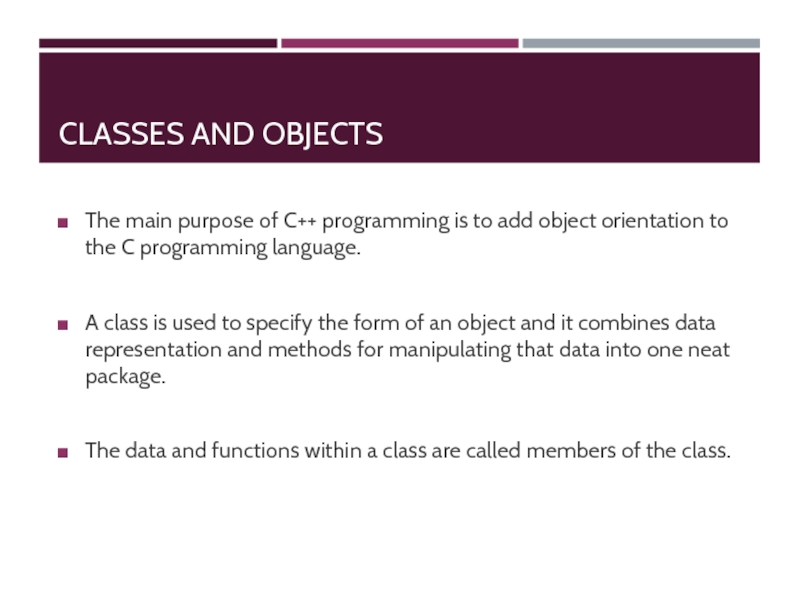
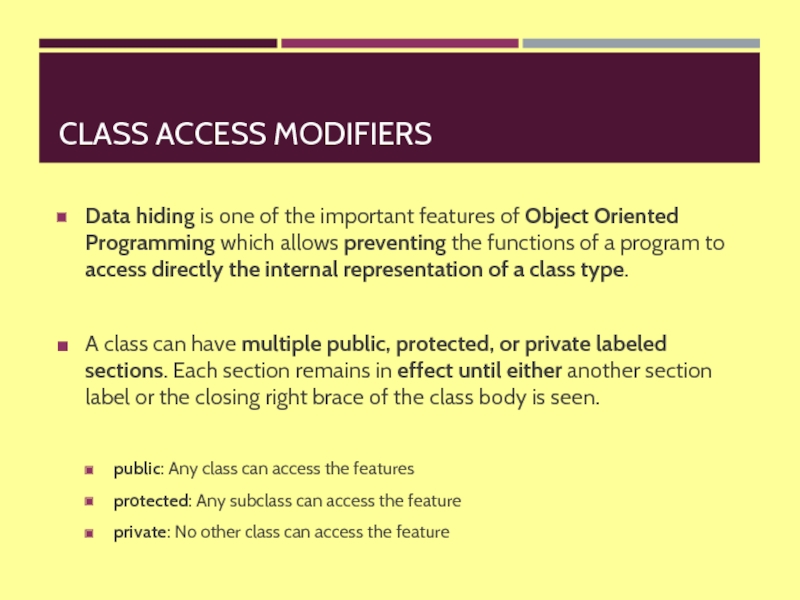
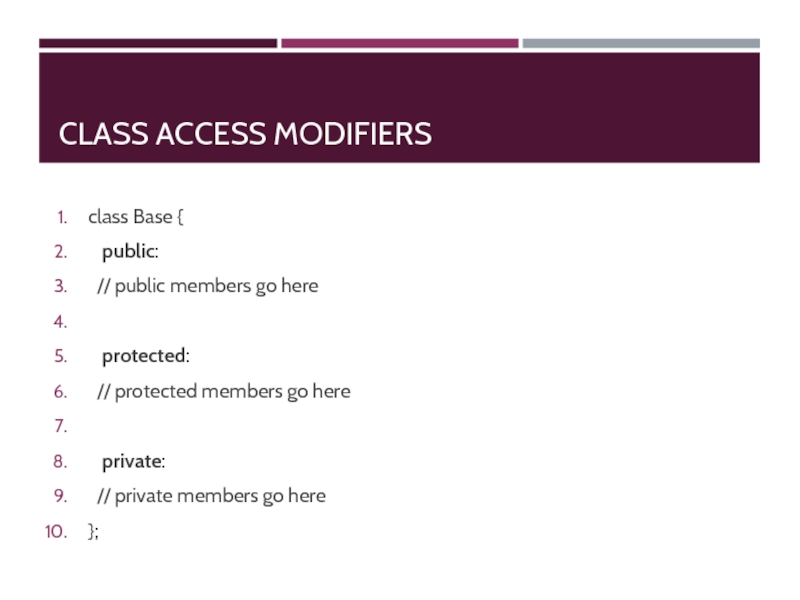
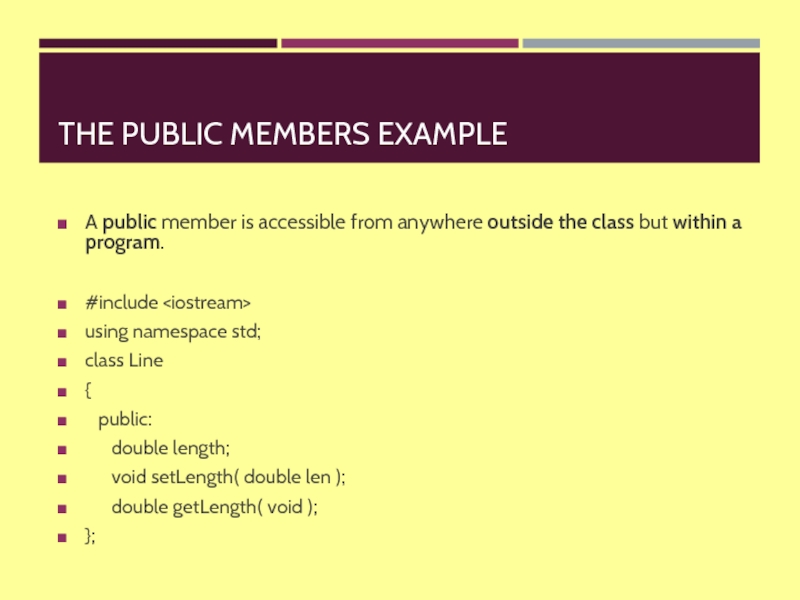
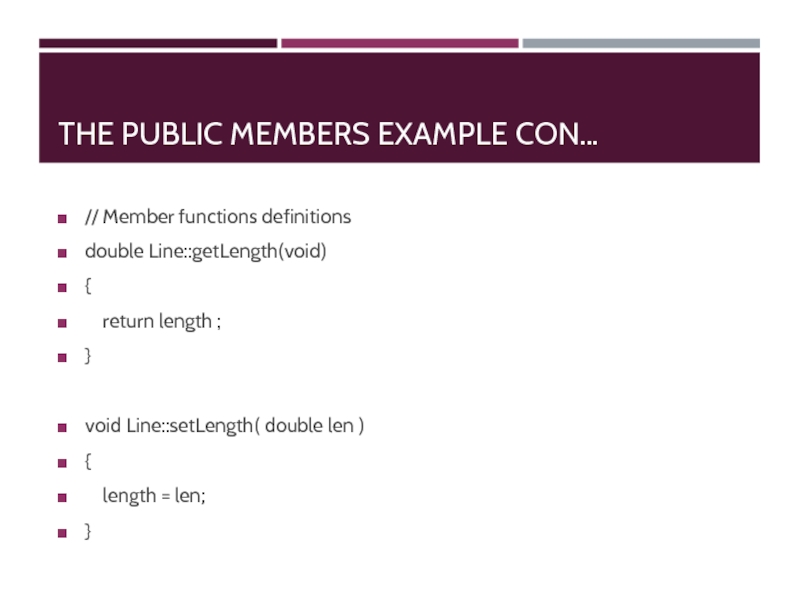
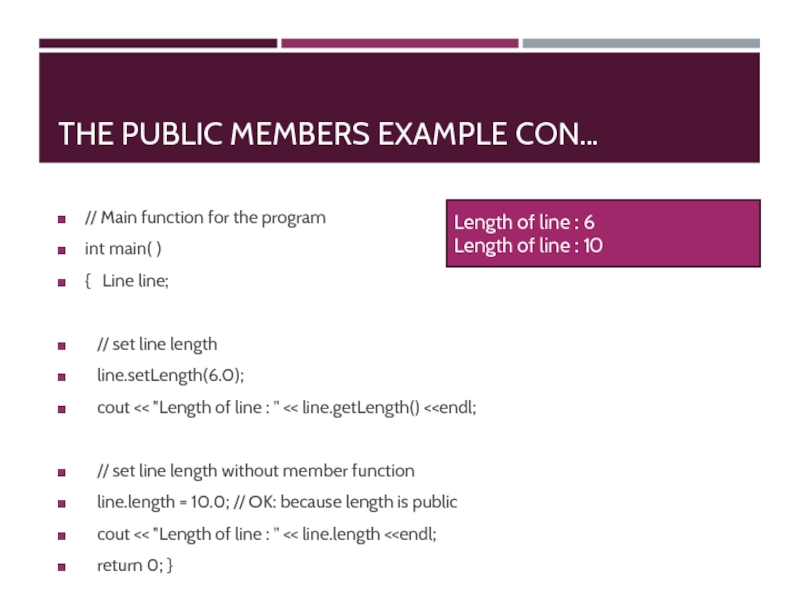
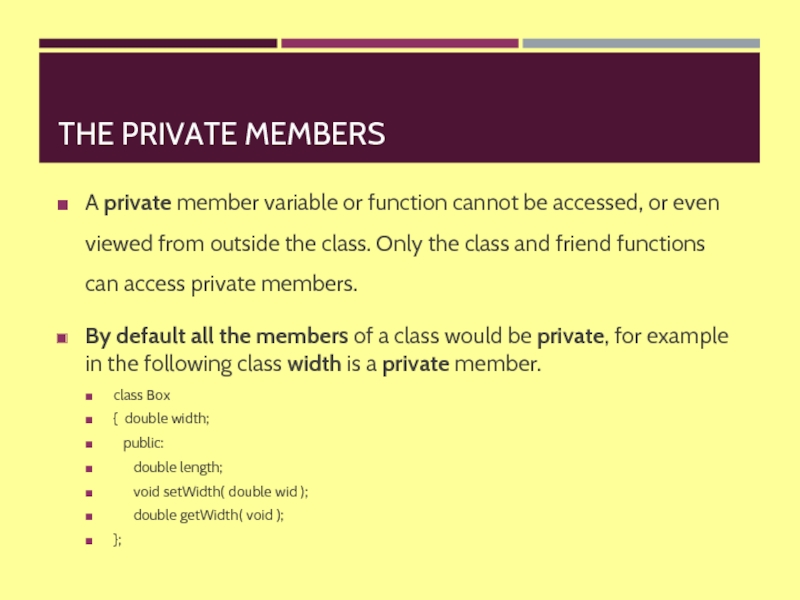
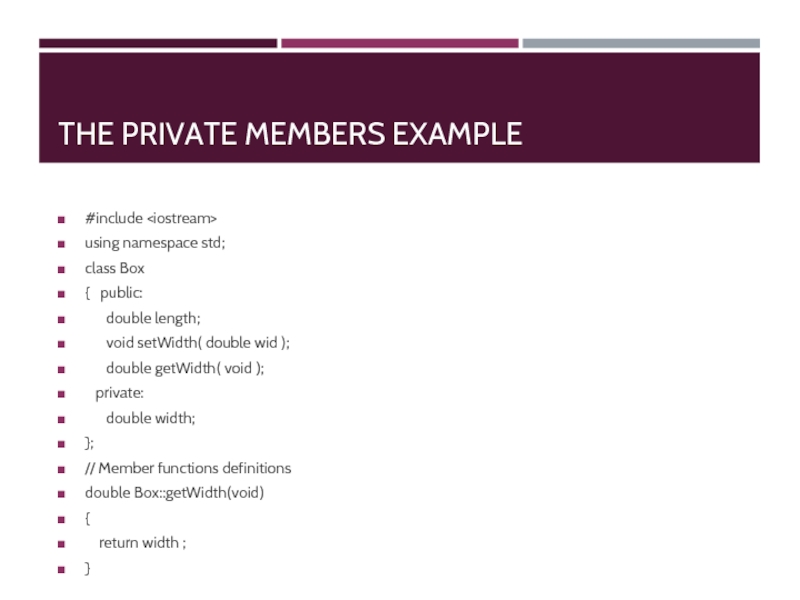
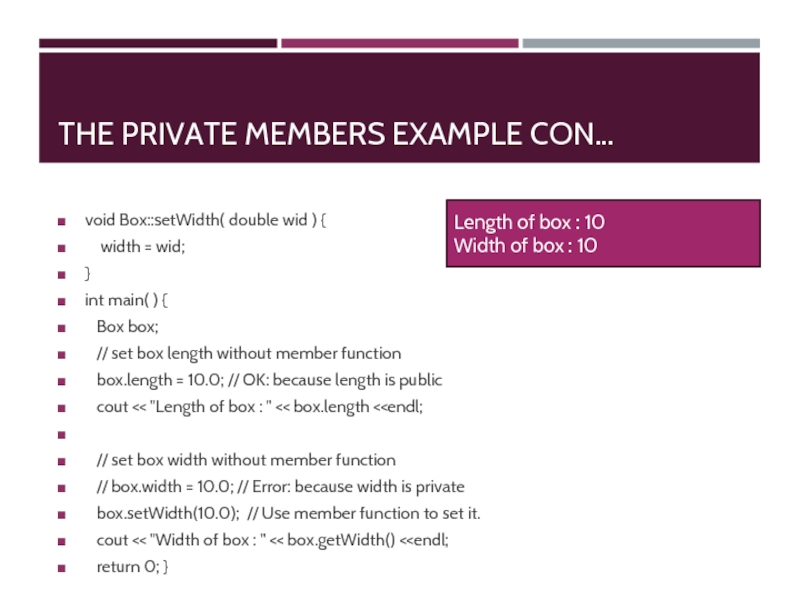
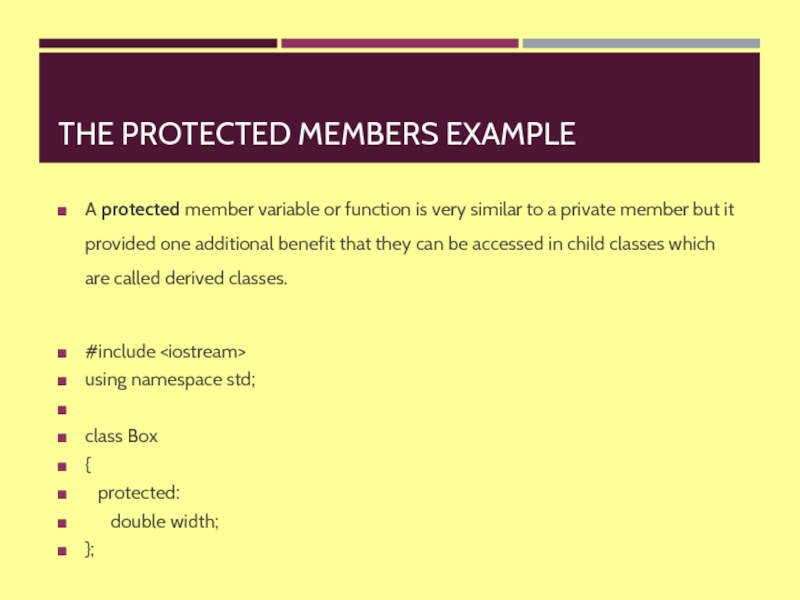
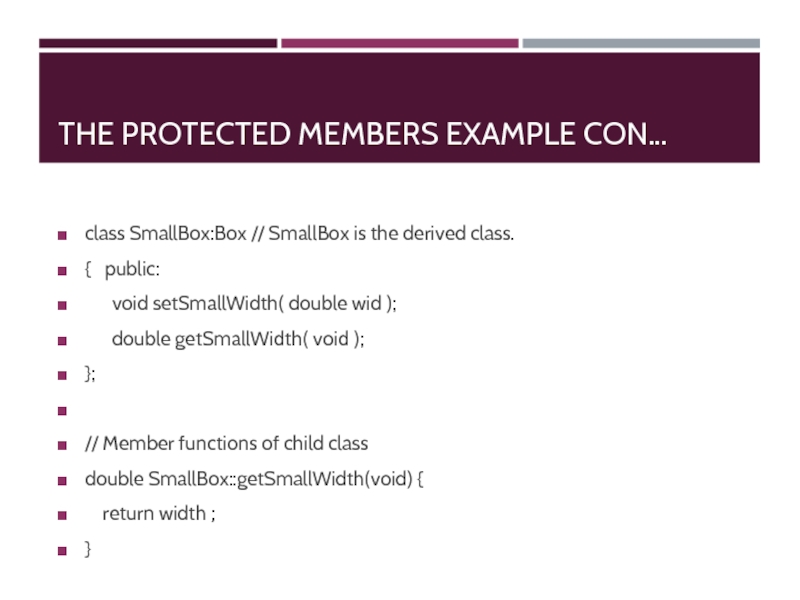
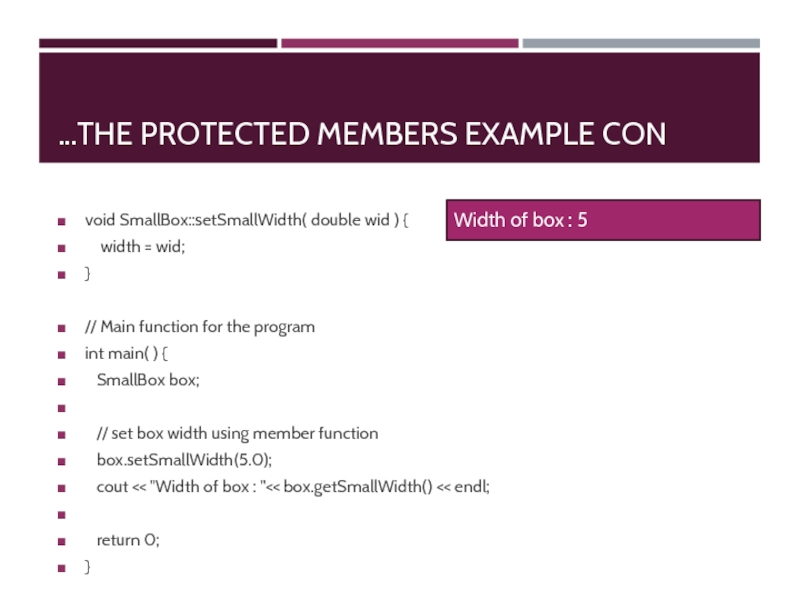
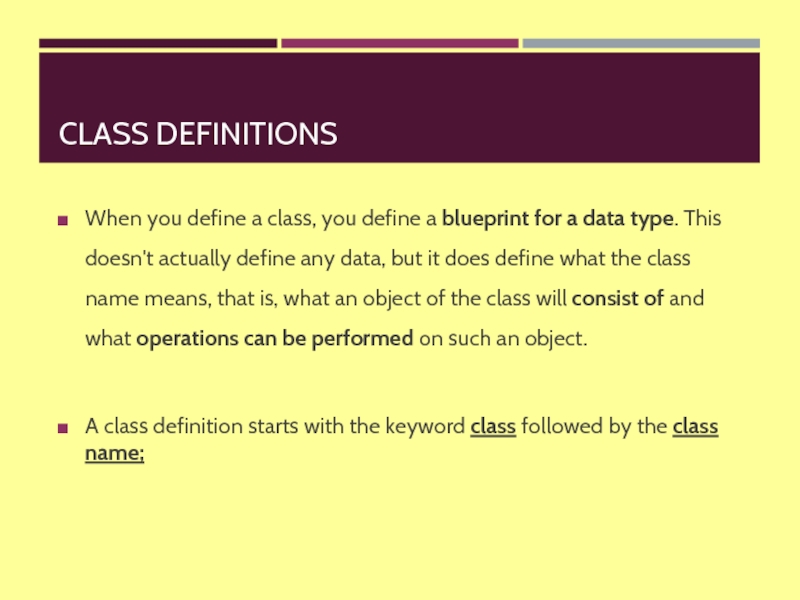
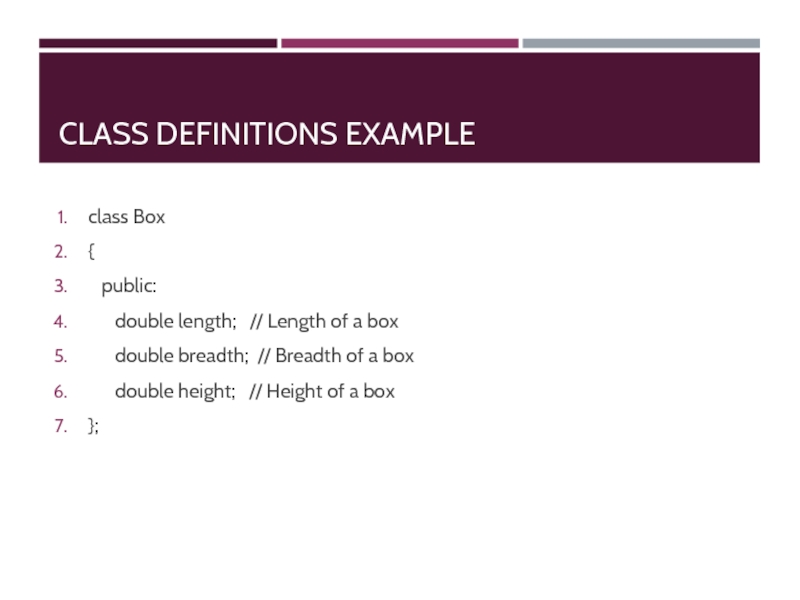
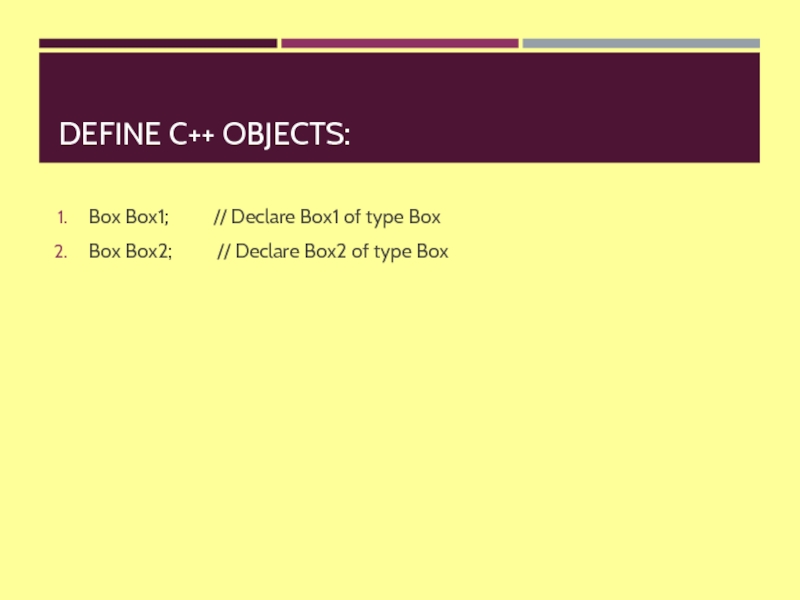
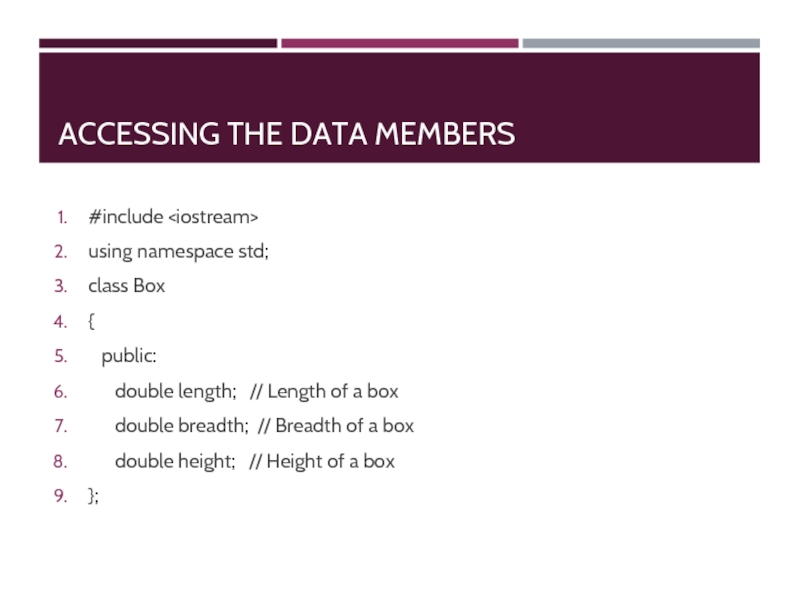
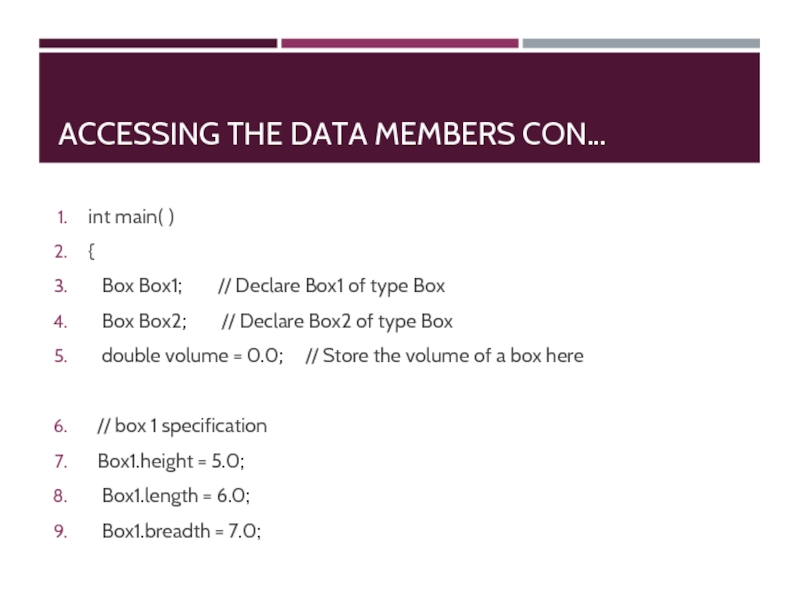
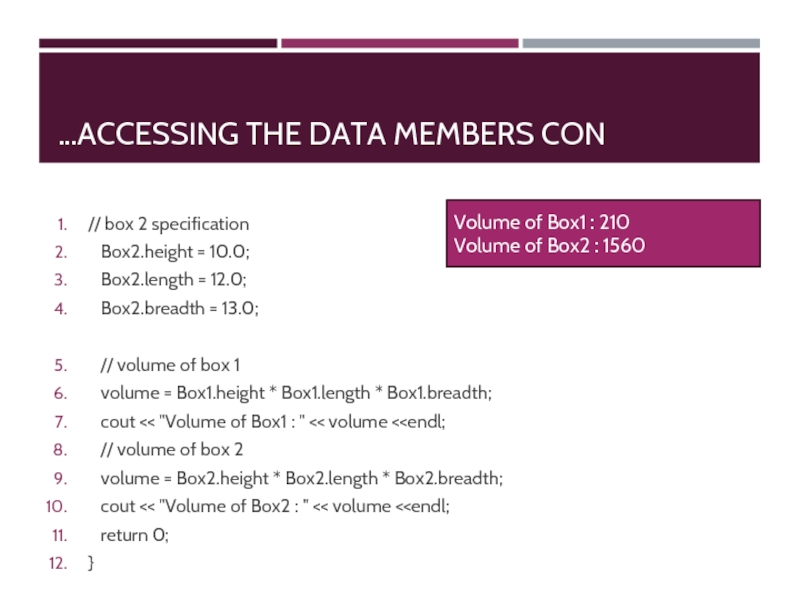
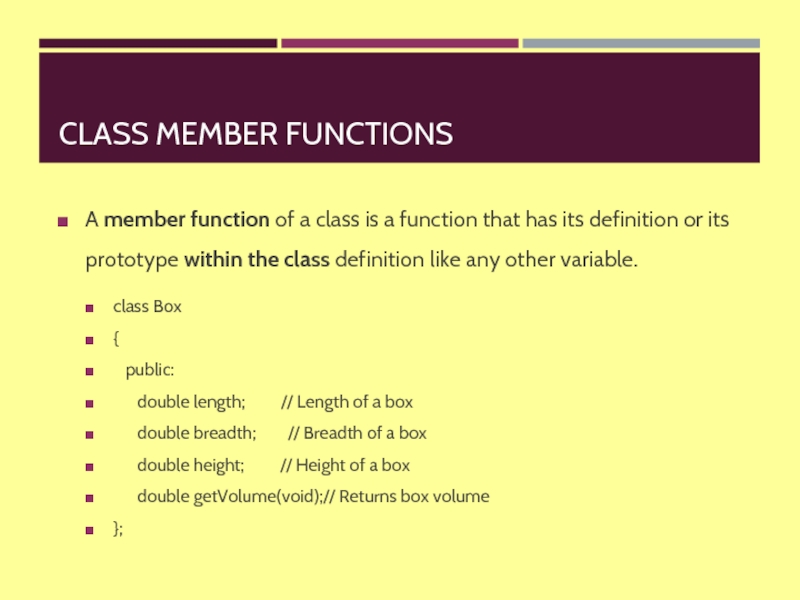
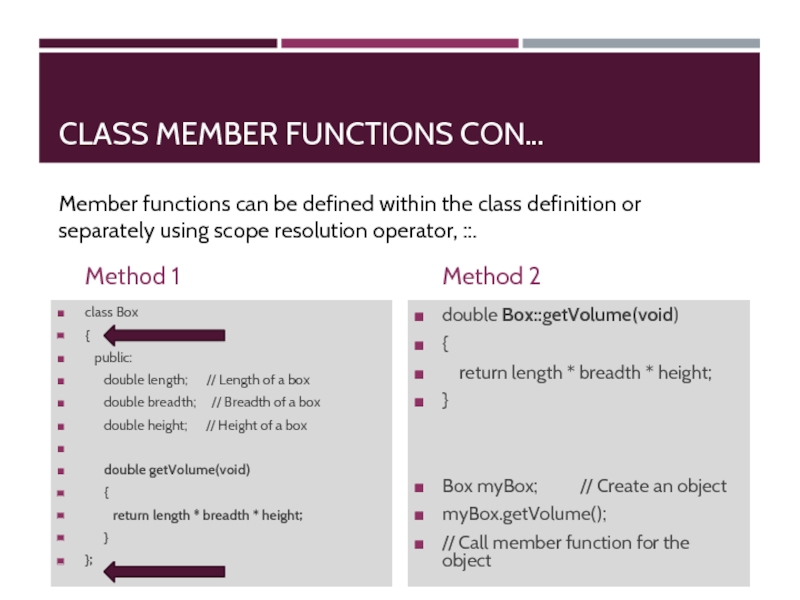
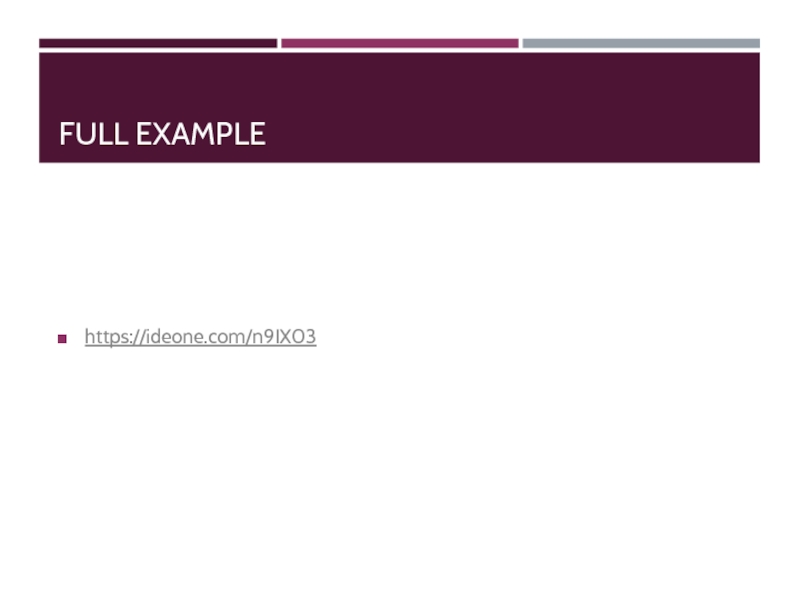
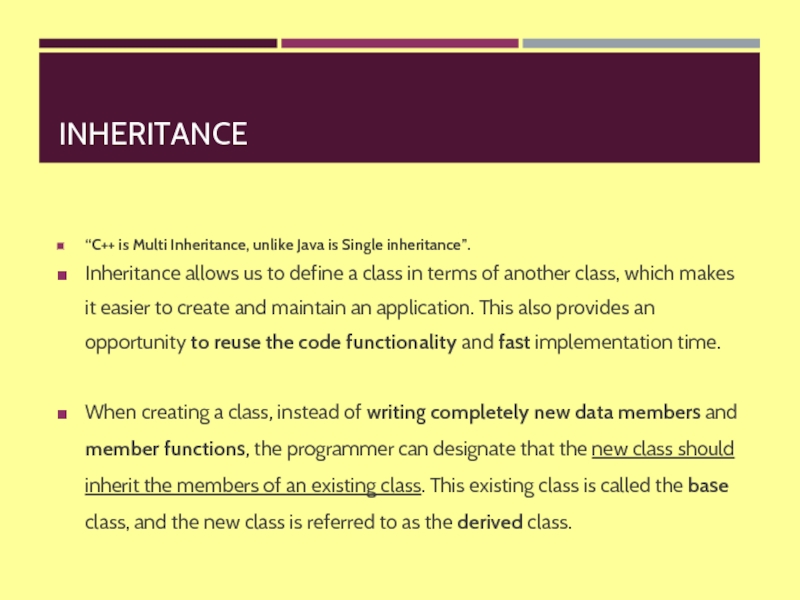
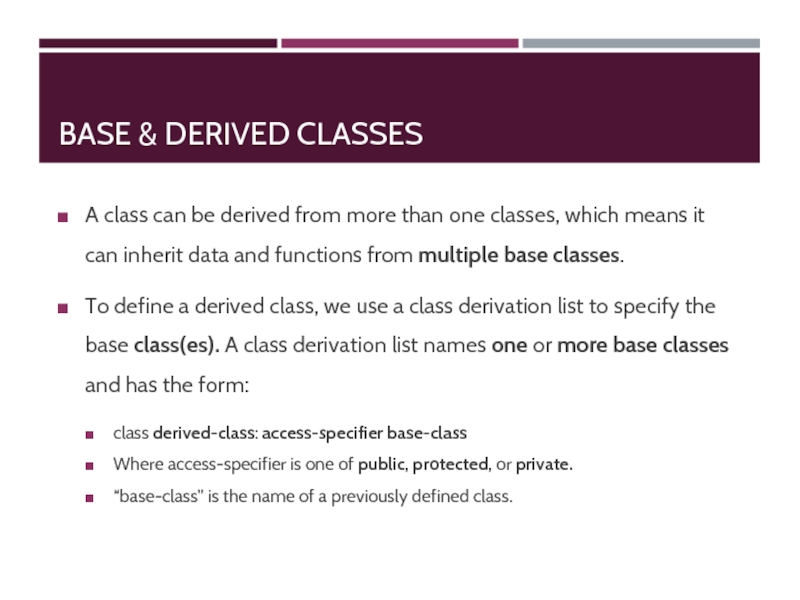
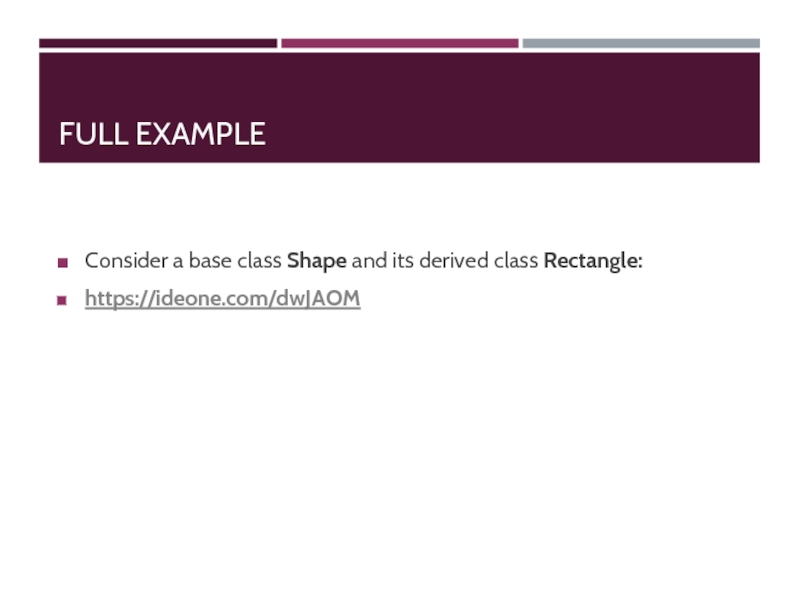
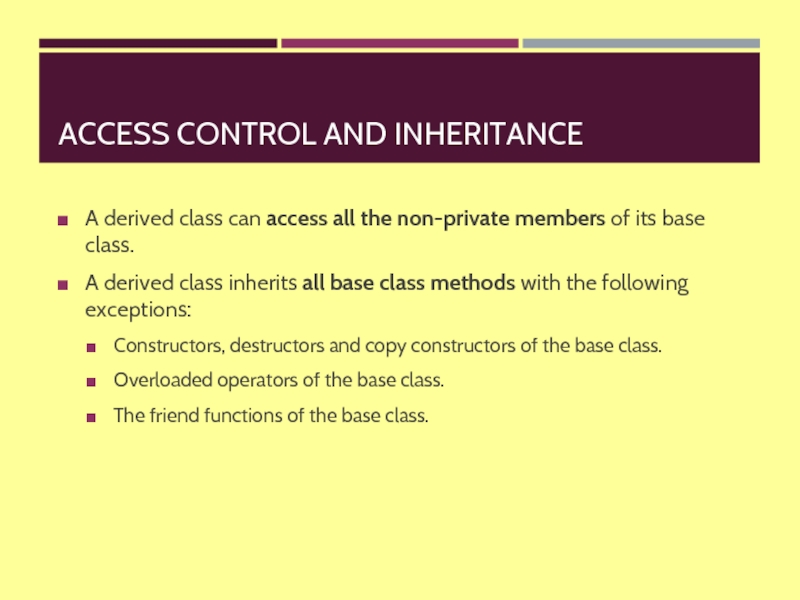
![TYPE OF INHERITANCE [ PUBLIC ]Public Inheritance:When deriving a class from a public base class, public members of](/img/tmb/2/180676/eb9dec3ad365df1c1a6cf9177baef302-800x.jpg)
![TYPE OF INHERITANCE [ PROTECTED AND PRIVATE ] CON…Protected InheritanceWhen deriving from a protected base](/img/tmb/2/180676/27916363aff21eeb554124d143733864-800x.jpg)
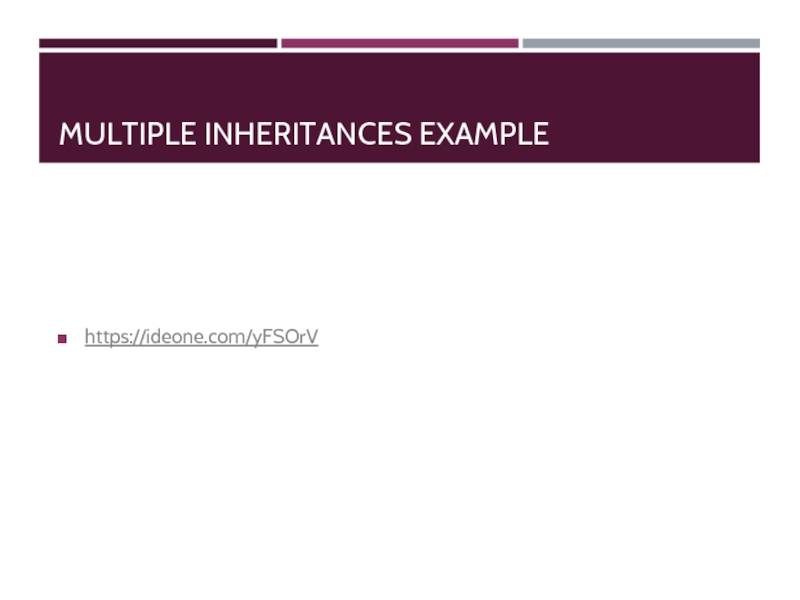
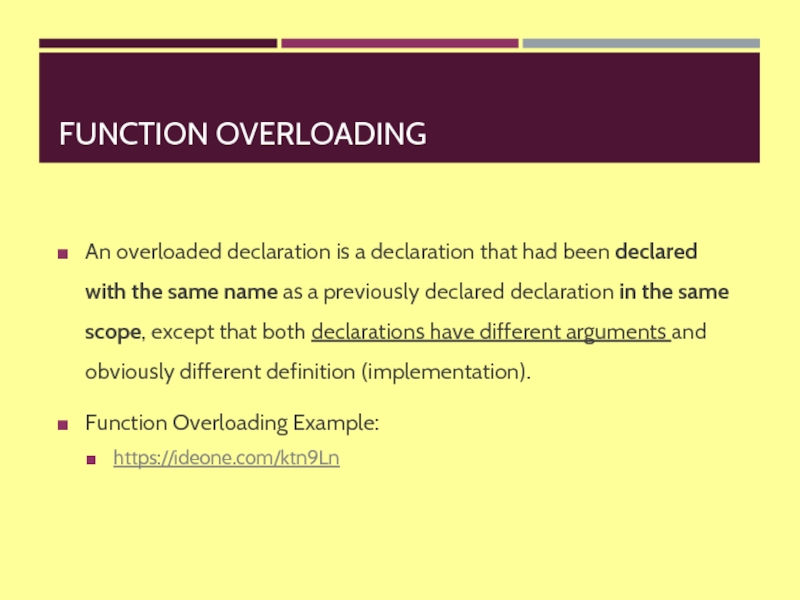
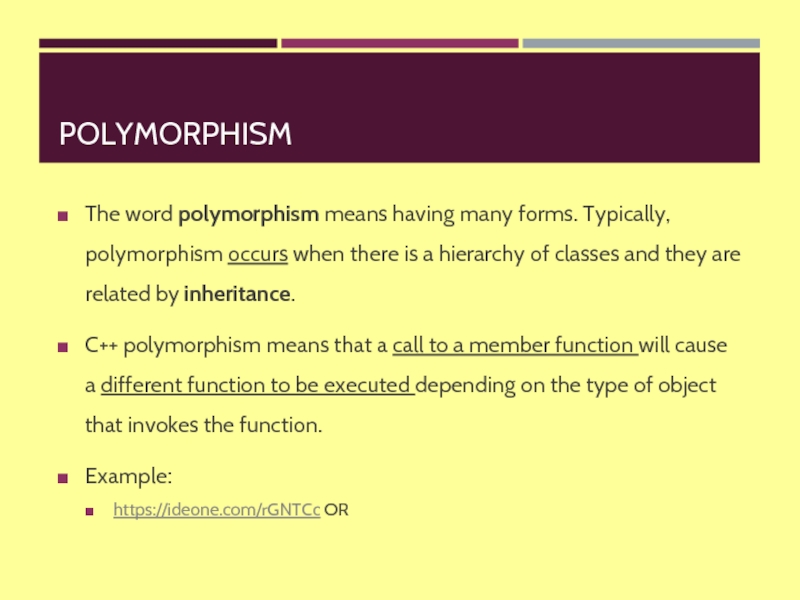
![POLYMORPHISM [STATIC RESOLUTION ]Output of previous example: WHY !!!The reason for the incorrect output is](/img/tmb/2/180676/4b971b19d8e634823a3b49c5e93a2e66-800x.jpg)
